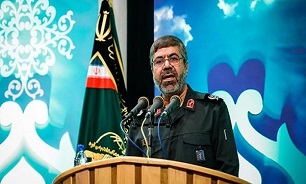Most Advanced Tools Used by Rioters in Iran
 "The outlaws used the most equipped tools and most professional methods in the recent sedition," General Sharif said, addressing a forum in the Central city of Arak on Monday.
"The outlaws used the most equipped tools and most professional methods in the recent sedition," General Sharif said, addressing a forum in the Central city of Arak on Monday.
He noted that the riots were fomented in Iran after the country succeeded in defeating the ISIL terrorist group, the resistance front gained great victories and the IRGC shot down an intruder US spy plane over the Iranian territories on June 20.
"The enemies are seeking to make up [for their failure] after every success Iran earns," General Sharif said.
On November 15, the government raised Iran’s extremely cheap gas price in order to moderate the national consumption rate, which stands at 110 million liters per day, 40 million liters above the maximum domestic requirement.
The government also announced a number of aid and subsidiary programs to protect vulnerable households from the adverse effects of the measure.
The price reform, required by Iranian legislature and essential as US-imposed sanctions seek to deplete Iran's budgetary resources, had been long delayed due to concerns regarding the move's probable backlash.
The measure's adoption prompted initially peaceful protests, but riotous elements, abusing the situation, quickly entered the scene, destroying public property, setting ablaze banks and gas stations among other facilities, and opening fire on people and security forces.
Intelligence reports and eye-witness accounts showed that the rioters who had taken advantage of public protests against gasoline price hikes to stir chaos in the country were armed with different weapons.
The protest rallies of Iranian people against the gasoline rationing turned violent since the first hours of the gatherings after the rioters used weapons.
In Sirjan city in the Southern province of Kerman, for instance, armed hooligans were about to detonate gasoline tanks, and almost made it if it hadn't been for the immediate presence of the police troops on the scene.
Security and police reports said the large number of weapons in the hands of the outlaws and rioters which had turned the scene of protests into a battlefield was one of the main features of the unrests.
Investigations showed that most people shot in riots were targeted from behind or the sides from a short range and from among protestors.
Also, reports by the security bodies and witnesses indicated that many of the bullets were fired from inside the protesting crowd and with weapons not registered at official bodies.
Iranian Government Spokesman Ali Rabiyee announced last Monday that rioters used cold weapons and firearms during unrests in some cities and towns, killing and wounding a number of police forces.
"Based on reports, the rioters have repeatedly used cold weapons and firearms in some cities," Rabiyee told reporters in a press conference in Tehran.
Also, Commander of the Law Enforcement Police in Kurdistan province Brigadier General Ali Azadi announced that his forces had arrested 25 ringleaders of the recent riots, and seized 3 rifles from them.
"25 ringleaders and main culprits behind the riots in the two cities of Marivan and Sanandaj have been detained in coordination with the judicial officials and 3 firearms and some cold weapons have been discovered and seized from them," General Azadi said on Sunday.
Late last month, Secretary of Iran's Supreme National Security Council (SNSC) Ali Shamkhani said that Tehran had successfully thwarted an attempt by a small group of foreign-backed rioters to set oil facilities on fire in the iconic Persian Gulf port city of Assaluyeh, adding that the attack was meant to be in retaliation for Yemenis’ bombardment of the Saudi oil sites in September.
He added that during the recent unrests in the country, which came after the government’s decision to substantially increase the gas price, some rioters tried to attack the iconic Persian Gulf port city of Assaluyeh in the South of Iran.
“The attack on Assaluyeh had been planned by the enemy,” according to Shamkhani.
The top Iranian security official added, “the enemy appeared to be seeking to avenge what Yemen Ansarullah did in attacking Saudi facilities, but it failed”.
Message end/
